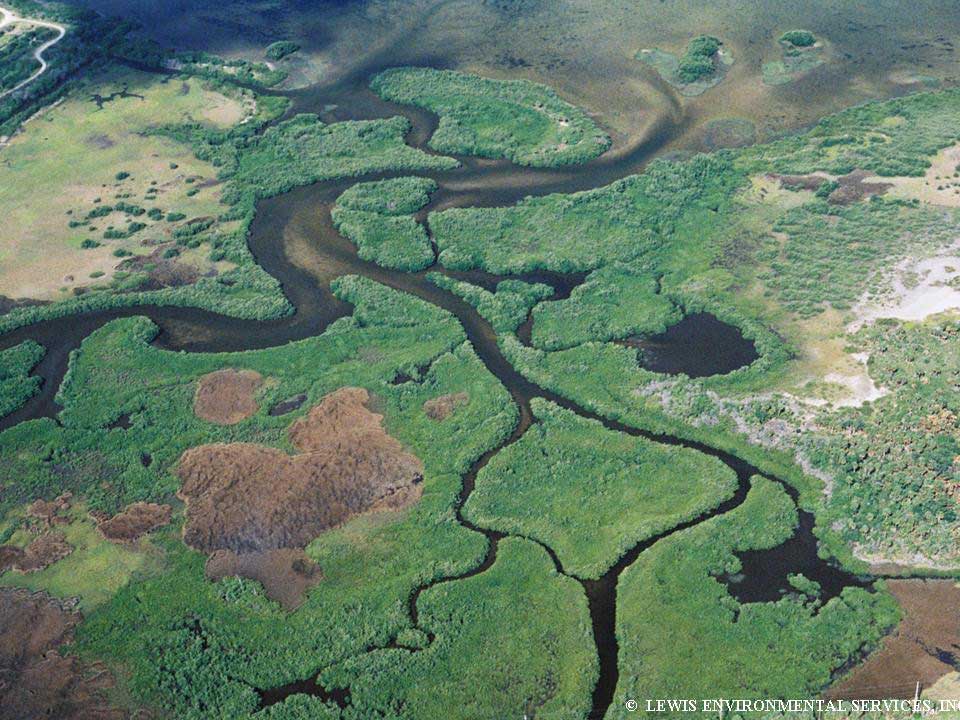Over time, however, the camp declined and the land was purchased by the fertilizer giant Mosaic Co. which already owned most of the property surrounding the site. Part of the upland site has been redeveloped as a memorial to the Giant, and Mosaic has begun restoring the mangrove forest around the camp.
Part of the restoration is mitigation for a 2004 breach in its gypsum stacks that released millions of gallons of acidic wastewater into Archie Creek and Tampa Bay, killing fish and damaging mangroves. Working with officials from the Environmental Protection Commission of Hillsborough County, Florida Department of Environmental Protection and the National Oceanic and Atmospheric Administration, Mosaic agreed to fund about $5 million in restoration projects.
While the spill occurred further north and Giant’s Camp wasn’t directly impacted by the spill, it offered a perfect opportunity for restoration, notes Robin Lewis, president of Lewis Environmental Services and lead contractor on the restoration. “Like many mangrove forests in the Tampa Bay region, mangroves in the middle of the site were dying off because construction of the marina in the 1950s included a seawall that blocked historic tidal flow through the mangroves,” he said. “It was an ecological heart attack waiting to happen.”
[su_pullquote align=”right”]The success of the project will be measured by improvements in water quality as well as an increase in fish populations, tracked through a multi-year monitoring project.– Tino Provenzano
Mosaic senior environmental specialist[/su_pullquote]
A 50-foot-wide and 5-foot deep channel from the long-abandoned marina basin will restore historic tidal flows through about 85 acres of mangroves, linking with remaining natural channels as well as channels restored by the Southwest Florida Water Management District’s SWIM (Surface Water Improvement and Management) program at the southeastern tip of the river’s shoreline.
“Originally the Alafia didn’t flow so directly into Tampa Bay, it took a turn to the south and flowed through these mangroves,” Lewis said. “We’re restoring part of that flow. If we didn’t do something now, they’d all be dead in 10 or 15 years.”
The success of the project will be measured by improvements in water quality as well as an increase in fish populations, tracked through a multi-year monitoring project, adds Tino Provenzano, Mosaic senior environmental specialist. Monitoring started in 2009 showed very large numbers of small fish including the highly sought-after snook, redfish and tarpon. Mullet – a favorite food of both snook and tarpon – also are expected to rebound with increased access to healthy mangrove forests.
Monitoring will continue for the next five years to provide in-depth data on the success of the restoration. “We see a lot of projects that do great work but skimp on monitoring so the results can’t be shared,” Provenzano said.
Clear results, including increased fish populations and documented improvements in water quality, would to help protect other mangrove forests in Tampa Bay and around the world, Lewis said. “The dying mangroves here are just the tip of the iceberg.”
Along with the channel to restore tidal flows, Mosaic will re-create oyster habitat in the marina basin with nearly 6,000 square feet of rip-rap and remove invasive plants from two acres near Lulu Road.
A separate project north of the Mosiac gypsum stack will create a series of natural habitats on land historically used as a burrow pit for fill to build nearby roads and railroads. Over time, the burrow pit was transformed into mangrove and saltern habitats surrounded by acres of Brazilian peppers.
Located between Old and New Highway 41, the project will start with an expanded tidal creek connecting to Delany Creek and include the creation of a one-acre shallow tidal pond and expansion of mangroves by re-grading the edges of the borrow pit. Salterns – rare hypersaline habitats that connect to saltwater only at very high tides – also will be restored and created. Approximately 16 acres of Brazilian peppers will be removed so native wetland plants can re-colonize naturally.
When complete, both projects will be placed under conservation easements that promise the lands will remain in their natural state forever.
In addition to funding projects that mitigate for the loss of fish and vegetation following the spill, Mosaic has spent $30 million reinforcing the berms on its gypsum stack and other water control measures to prevent any future leaks from the gypsum stack.
[su_divider]